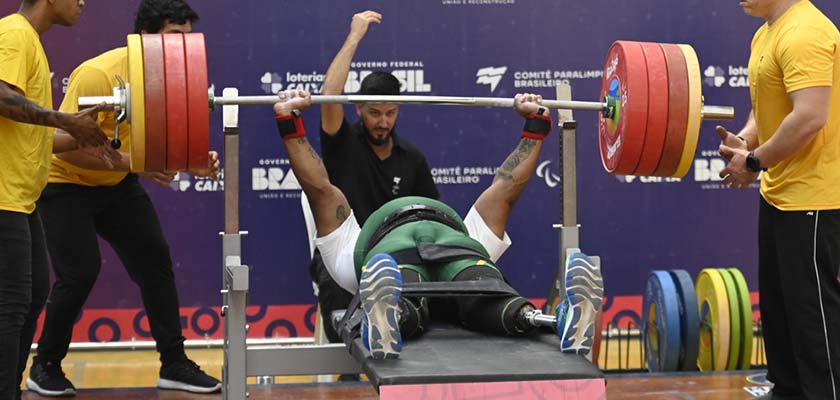Do you already know everything about paralympic weightlifting? Then it’s time to take that knowledge to another level by looking at every rule that forms part of the sport. Check out our complete guide to all the rules of paralympic weightlifting.
Participate in our free Whatsapp community and receive daily tips, news and trivia from over 50 sports! Click here to join.
Paralympic weightlifting rules: modalities
There are three paralympic weightlifting disciplines: bench press, development and snatch. Each discipline has its own specific rules for execution and scoring.
Bench Press
In this discipline, the athlete lies on a horizontal bench and lifts a bar loaded with weights until their arms are outstretched. The athlete must keep their feet on the floor throughout the movement and their body must remain in contact with the bench.
A referee will give the signal to start the lift. The athlete lowers the bar until it touches their chest, keeping it under control, and then raises it until their arms are fully extended.
Basically, in the rules of paralympic weightlifting, the athlete has three attempts and the aim is to lift as much weight as possible. The score is determined by the total weight lifted correctly in the competition.
Powerlifting – Shoulder Press
In the development, the athlete lifts a bar loaded with weights from the shoulder position until the arms are fully extended above the head.
The competitor sits or stands, depending on the category. It works like this: the referee gives the signal to start the lift. The athlete lowers the bar to their shoulders, keeping it under control, and then raises it until their arms are fully extended above their head.

As with the bench press, the athlete has three attempts to lift as much weight as possible. The score is determined by the total weight lifted correctly in the competition.
Powerlifting – Deadlift
In the snatch, the athlete lifts a bar loaded with weights off the ground until they are completely upright, holding the bar in front of their thighs with their hands.
The competitor starts with the barbell on the floor, and when they are ready, they pick it up and lift it until they are completely standing, extending their hips and knees.
The hands can be in different positions on the bar. The referee gives the signal to start the lift, and the athlete has full control over the movement.
As with the other Paralympic weightlifting rules, the athlete has three attempts to lift as much weight as possible, and the score is determined by the total weight lifted correctly in the competition.
Paralympic weightlifting rules: scoring
If you’re wondering how paralympic weightlifting is scored, we’ve got you covered! Basically, it is determined by the total weight lifted correctly by the athlete during the competition.
Lifting attempts
During the competition, each athlete has the opportunity to make three attempts at each of the lifts (bench press, development and snatch). The aim is to lift as much weight as possible in each of these attempts.
Weighing surveys
The weight lifted on each attempt is recorded by the referees in charge. This includes not only the weight of the bar discs, but also the weight of the bar itself.
Valid attempts
For a lift to be considered valid, the athlete must touch their chest in the bench press, fully extend their arms in the development and lift the bar until they are completely upright in the snatch.
Total weight lifted
At the end of the competition, the total weight lifted correctly in all valid attempts is added together to determine the athlete’s final score. This includes the weight lifted in each of the lifts.
Paralympic weightlifting rules: eligible disabilities
There are disabilities eligible for Paralympic weightlifting, such as: cerebral palsy, amputation and spinal cord injury. Each category is designed to ensure fair and safe competition for competitors. Below, we’ll go into more detail about each one.
Cerebral palsy
In the case of cerebral palsy, the classification is based on the type and degree of impairment. Thus, athletes are classified from P1 to P5 (P1 represents the highest degree of impairment and P5 represents the lowest). Some athletes with cerebral palsy can compete in combined classes, such as CP1-5.
Amputation
Amputation also generates a classification based on type and level. Thus, the classifications range from P1 to P4. The logic is the same as for cerebral palsy: P1 represents the highest degree of disability, and P4 the lowest. There is also the possibility of combined classes.
Spinal Cord Injury
Spinal cord injuries include paraplegia or tetraplegia. This type of paralympic weightlifting-eligible disability is also classified based on the level of the injury and the degree of impairment, from P1 to P5. In this case, competitors can also compete in specific classes for wheelchair users or in combined classes.
Combined classes
The combined classes in paralympic weightlifting group together athletes with different types of disabilities, but with similar levels of functionality in relation to the sport.
So what happens: instead of dividing athletes strictly based on the specific type of disability, the combined classes consider the athlete’s overall functionality in relation to weightlifting. This can include factors such as the ability to perform weightlifting movements safely, muscle strength and body stability.
The combined classes within the Paralympic weightlifting rules are designated by letters and numbers, such as “K44” or “F55”, where the letter represents the general type of disability (e.g. “K” for amputations) and the number indicates the athlete’s level of functionality within that category. The lower the number, the greater the athlete’s functionality within the class.
Now that you know all the rules of paralympic weightlifting, you’re ready to learn about other sports. Check out our content:





